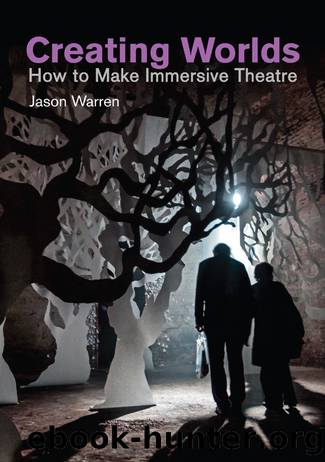Creating Worlds: How to Make Immersive Theatre by Jason Warren

Author:Jason Warren [Warren, Jason]
Language: eng
Format: epub
ISBN: 9781848424456
Google: K-NaMQAACAAJ
Publisher: Nick Hern Books Limited
Published: 2017-11-15T23:31:41.199182+00:00
Choosing Factions II
Before we move on to look at how these Factions can interact with your play, itâs time to come clean â I lied when I said there were three rules. There is a fourth, and much more important rule.
RULE 4: Ignore these rules.
When you understand how and why these rules work, you can start rejecting them. Itâs important to understand why these groups work so well because you can then approach other kinds of Faction with open eyes. When you break these rules, youâll have a good understanding of what obstacles youâre creating to overcome later. I might break Rule 3, and decide itâd be very interesting to make my audience kings and popes while the cast are mere dukes and bishops⦠But because I looked at these rules, I now know Iâm going to have to plan for their ability to affect the story. Maybe I go the other way, and make them downtrodden peasants because itâd be exciting to see them rebel against the play and their place within it. Again, Iâm armed with the knowledge of what problems this is going to throw at me.
Influence
Having the power to interact and shape a play can be intoxicating for an audience member; weâre so used to sitting down and listening that a new, different dynamic is exciting. If youâre going to manage what the audience throw at you, the productionâs non-interactive elements need to be just as engrossing! The first step in creating manageable interactions is making sure that the audience are never so bored that they become disruptively proactive when you havenât planned for it.
This means, and Iâll say this repeatedly, that the traditional elements of your show must be as honed and professional as the immersive parts!
Letâs assume youâre going to make that happen and that you already know how to make your scenes compelling. Our next stop is looking at the interactive segments themselves. One of our first concepts here is Influence. This is simply a shorthand way of saying âHow extensively can this interaction affect the production?â Itâs how we distinguish the small-scale interactions that go on all the time from the large game-changing ones that profoundly affect the play. This isnât a binary choice (big or small) but a sliding scale. How you identify and rate the Influence of your interactions is up to you, but one possibility is to consider how much work the cast have to do (both in rehearsal and in the production itself) to react successfully to that interaction. Strictly speaking, these are separate considerations, and in your early explorations of this kind of work you may wish to separate this concept into Impact (the level of work required by the cast) and Influence (the level of importance the interaction has on the productionâs progress).
Examples will be more helpful here⦠In Loveplay, audience members would often ask a cast member a simple question. Thatâs a very small and easily handled interaction. It didnât have much Influence, as it
Download
This site does not store any files on its server. We only index and link to content provided by other sites. Please contact the content providers to delete copyright contents if any and email us, we'll remove relevant links or contents immediately.
Kathy Andrews Collection by Kathy Andrews(11706)
The remains of the day by Kazuo Ishiguro(8787)
Paper Towns by Green John(5063)
Spare by Prince Harry The Duke of Sussex(5052)
The Body: A Guide for Occupants by Bill Bryson(4950)
Industrial Automation from Scratch: A hands-on guide to using sensors, actuators, PLCs, HMIs, and SCADA to automate industrial processes by Olushola Akande(4910)
Machine Learning at Scale with H2O by Gregory Keys | David Whiting(4101)
Be in a Treehouse by Pete Nelson(3922)
Never by Ken Follett(3760)
Harry Potter and the Goblet Of Fire by J.K. Rowling(3758)
Goodbye Paradise(3709)
Into Thin Air by Jon Krakauer(3288)
The Remains of the Day by Kazuo Ishiguro(3279)
The Cellar by Natasha Preston(3241)
The Genius of Japanese Carpentry by Azby Brown(3208)
Fairy Tale by Stephen King(3192)
120 Days of Sodom by Marquis de Sade(3160)
The Man Who Died Twice by Richard Osman(2977)
Drawing Shortcuts: Developing Quick Drawing Skills Using Today's Technology by Leggitt Jim(2974)
